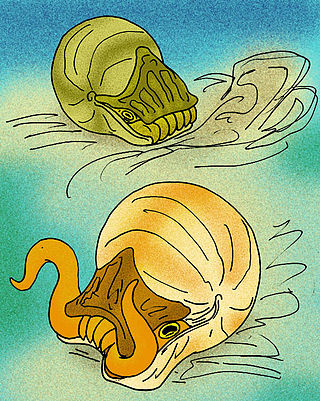Kabylites is a narrow, straight shelled Lower Cretaceous ancyloceratid resembling Bochianites in general form. Kabylites differs from Bochianites in having an umbilical lobe more or less the same size as the first lateral lobe. In Bochianites the umbilical lobe is much reduced in size.
Alocolytoceras is a lytoceratid ammonite with whorls that pass during growth from round to oval, rounded-quadrate, or compressed; with about 19 deep constrictions per whorl, with as many as 21 sharp ribs in between. The shell is evolute. All whorls are visible from either side.
Analytoceras is an extinct genus of cephalopod belonging to the Ammonite subclass that lived during the early Jurassic. Analytoceras, named by Alpheus Hyatt in 1900, is a lytoceratid and only member of the pleuroacanthitid subfamily Analytoceratinae, which has the same characters as its genus.

Audaxlytoceras is an extinct genus of lytoceratid ammonites.

Arcestes is a genus of extinct ceratitid ammonites found in Triassic-aged marine strata.
Dobrogeites is a genus of ammonoids from the order Ceratitida, included in the family Megaphyllitidae that produced evolute compressed planispiral shells with rounded venters, inner whorls ornamented as in Tirolites, outer whorls smooth, suture with multiple smooth lobes; Initially found in Anisian sediments in Romania.

Exiteloceras is an ammonite genus from the Late Cretaceous.

Cenoceras is an extinct genus within the cephalopod mollusc family Nautilidae, which in turn makes up part of the superfamily Nautilaceae. This genus has been described by Hyatt in 1884. The type species is Cenoceras intermedium (Sowerby).
Sholakoceras is an extinct genus of nautiloid cephalopods from the Lower Permian of southern Russia, included in the Tainoceratacean family Rhiphaeoceratidae,. The shell of Shalakoceras is evolute with a perforate umbilicus. Whorl sections are subquadrate with the ventral and lateral sides flattened and ventral and umbilical shoulders rounded. Lateral areas bear short, slightly oblique ribs. sutures form broad ventral saddles with a slight, shallow lobe, very shallow lateral lobes, and a deep funnel-shaped dorsal lobe.
Neocycloceras is an extinct genus of nautiloid included in the Pseudorthocerida that lived during the Late Devonian and Mississippian. Neoclycloceras is characterized by a slender, generally circular shell with slightly oblique, sinuous surficial annulations. Its sutures have dorsal and ventral saddles and lateral lobes and become more oblique with age. Saddles point forward, lobes to the rear. Dorsal saddles are broad and low but the ventral ones are high and conspicuous. The siphuncle is located between the center and venter and is nummuloidal, composed of rounded expanded segments, the inside of which contains a continuous laminar lining that is thickest in the middle of the segments and thinnest at the septal necks. Neocycloceras has been found in Pennsylvania in North America and in Morocco in north Africa.
Stearoceras is an extinct genus of prehistoric nautiloids from the Lower Pennsylvanian - Lower Permian with a fair worldwide distribution.(Kümmel 1964)

Craspedites is an ammonoid cephalopod included in the Perisphinctoidea that lived during the Late Jurassic and Early Cretaceous, found in Canada, Greenland, Poland, and the Russian Federation.

Lytoceratidae is a taxonomic family of ammonoid cephalopods belonging to the suborder Lytoceratina, characterized by very evolute shells that generally enlarge rapidly, having whorls in contact but mostly overlapping very sightly, or not at all.

Hypophylloceras is a Cretaceous ammonite with a finely ribbed, compressed, involute shell; some having periodic stronger ribs or folds. The suture is complex, with large, asymmetric and finely divided lobes; the 1st lateral being much larger than the external (=ventral) and 2nd lateral lobes. Saddle endings commonly not phylloid.
Pleuroacanthites is one of two genera included in the Early Jurassic Pleuroacanthitidae and sole representative of the subfamily Pleuroacanthitinae. The shell of Pleuroacanthites is very evolute, with numerous whorls subcircular in section becoming incipiently keeled in the adult. Early whorls have parabolic nodes, later whorls are covered with oblique line which form a long ventral sinus. Sutures have lytoceratid (moss-like) lobes but more or less phylloid saddle endings.

Neocomites is a genus of ammonite from the Lower Cretaceous, Berriasian to Hauterivian, and type genus for the Neocomitidae.

Protetragonites is an extinct genus of ammonoid cephalopods belonging to the family Lytoceratidae. These fast-moving nektonic carnivores lived from the Jurassic period Tithonian age to the Cretaceous period Aptian age.
Eophyllites is a genus of ammonoid cephalopods from the Lower Triassic and a predecessor of genera like Monophyllites and Ussurites.
Palaeophyllites is a genus of ammonoids from the Lower Triassic and a contemporary of the related ussuritid Eophyllites.
Leiophyllites is a genus of early to middle Triassic ammonites belonging to the family Ussuritidae, possibly forming an evolutionary link between Lower Triassic and later members of the family.








